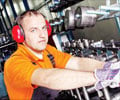Australian researchers have identified the cause of the squeaking noise emanating from hip transplants. They say the noise is generated by ceramic material rubbing on titanium.
Modern hip transplants involve ceramic and titanium parts and it is thought that the squeaking noise occurs when the ceramic part slips against the titanium part. The slipping may occur due to the titanium part deforming during insertion.It requires considerable force to implant the artificial cup into the pelvis and it is thought that this may deform the material which in turn makes the hip squeak.
When an undercover police officer realised his squeaking hip implant was jeopardising covert surveillance work, his surgeon turned to Industrial Research Limited to help solve the problem.
Capital and Coast District Health Board’s Professor Geoffrey Horne says the phenomenon of squeaking implants is not new. “They can be quite loud and in some cases the noise can be very disconcerting.”
While some research has been conducted into the phenomenon, its cause has largely been the subject of speculation.
IRL's Measurement Standards Laboratory scientist Eleanor Howick says recent acoustic suggests that the noise is generated by the ceramic material rubbing on titanium. “This implies that there is some slippage between the two surfaces caused by deformation of the materials.”
Advertisement
“By doing this we were able to prove that there was significant deformation of the implant as it was being inserted into the pelvis. We were also able to accurately measure the specific points subject to deformation.”
Advertisement
Source-Medindia
GPL/L









